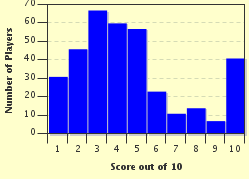Quiz Answer Key and Fun Facts
1. What metallic element gives the brilliant red and green color to rubies and emeralds?
2. The North America Nebula appears to be in what constellation as seen from Earth?
3. What era do geologists term the current time in Earth's geologic history?
4. What description fits the Pistol Star most closely?
5. My niece showed me a nice piece of gneiss. What is likely to be its most prominent feature?
6. Is there an asteroid named Groucho Marx?
7. The Catskill Mountains are normally classed as being part of what mountain chain?
8. Who were the last two humans to walk on the moon in the 1970s?
9. Which feature would you NOT see depicted on a USGS (United States Geologic Survey) map?
10. About how long is a parsec?
Source: Author
debodun
This quiz was reviewed by FunTrivia editor
crisw before going online.
Any errors found in FunTrivia content are routinely corrected through our feedback system.


